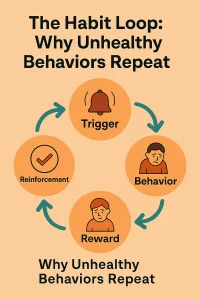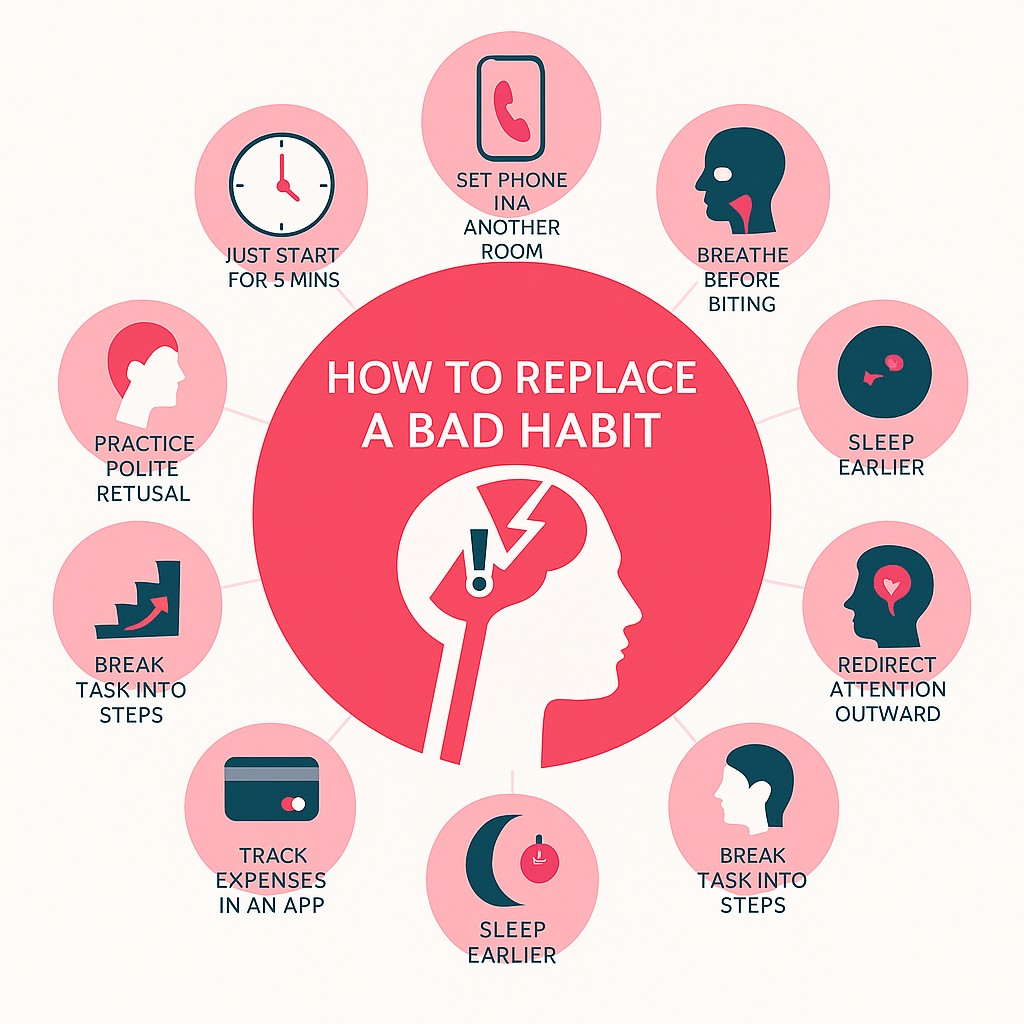 The 11 Most Common Bad Habits and How to Finally Fix Them
The 11 Most Common Bad Habits and How to Finally Fix Them
The scariest part isn’t when patterns take over, it’s how normal they feel.
If you’re fed up of the same cycle – promise, try, fail, repeat – there’s a different way that actually works. Most common bad habits aren’t character flaws. They’re solutions to problems you might not know you’re solving in ways that hurt you.
Sound familiar? Standing in your kitchen at 11:30 pm again. You’re mindlessly eating chips straight from the bag, like you’re zoned out. Despite promising yourself that morning you were done with late-night snacking for good.
Worst part? It wasn’t hunger driving this behavior at all. It was pure habit and automatic response. A pattern so deep you barely noticed it. That’s the thing about such behaviors. They don’t announce themselves with flashy warning signs, they sneak in through the back door, quietly. They meet real needs in ways that hurt, and they stick around not because you’re weak. They stay because they’re solving problems effectively. Just not in ways that help long-term.
Why Common Bad Habits Are So Hard to Break
 Everything changes when you realize these aren’t character flaws and you’re not a failure. They’re your brain’s confused attempts to help you. Understanding common bad habits begins with moments of recognition.
Everything changes when you realize these aren’t character flaws and you’re not a failure. They’re your brain’s confused attempts to help you. Understanding common bad habits begins with moments of recognition.
You just wake up one day and feel it. This background feeling that the way you’re living isn’t working. But the patterns are so established you can’t imagine living any other way.
The breakthrough comes when you understand that willpower isn’t the answer. These behaviors aren’t character flaws. They’re responses to needs or uncomfortable feelings. Unless you address what’s driving the habit, you’ll keep going back to old patterns.
When people finally understand that habits serve purposes, everything shifts in their approach to change. Instead of fighting against them with pure determination, they can get curious about the underlying needs they meet.
The Science Behind Common Bad Habits
Most common bad habits start as solutions to real problems. Your brain learns that certain behaviors provide relief or reward. But over time, these become automatic responses that happen without conscious thought.
The reason common bad habits are so persistent isn’t because you’re weak. It’s that they’re serving important psychological needs; security, comfort, excitement, connection – these are basic human needs. When healthy ways to meet these needs aren’t available, your brain finds alternatives.
What makes these patterns so tricky is that they actually work in the short term. Scrolling your phone does give temporary distraction. Eating when stressed does offer momentary comfort. Avoiding difficult tasks does eliminate immediate anxiety.
But over time, common bad habits stop working as well. They create more problems than they solve.
- Endless Scrolling Through Social Media
The average American spends over three hours daily on their phone scrolling mindlessly through content. Much of it through social media and news.
This habit isn’t just a time-waster at all. It’s a life-waster that steals precious moments of potential connection, creativity, and genuine rest.
 What drives it: This habit usually meets needs for excitement, distraction from uncomfortable emotions, or connection. It provides the feeling of being productive. You think “well I’m staying informed” while actually draining mental energy and focus completely.
What drives it: This habit usually meets needs for excitement, distraction from uncomfortable emotions, or connection. It provides the feeling of being productive. You think “well I’m staying informed” while actually draining mental energy and focus completely.
How to fix it:
- Create phone-free zones in specific places and times. Try bedrooms, dining tables, first hour after waking.
- Replace the reward with something healthier. If you scroll when bored, keep books handy. If you scroll to feel connected, call a friend.
- Use app limits that most phones offer. Start with reducing usage by 25 percent. Then gradually decrease further over time.
- Procrastination – One of the Most Common Bad Habits
Putting off important tasks until the last minute creates stress everywhere. This ranks as one of the most common bad habits, it hurts work quality and breaks down self-trust.
Here’s the thing, delay isn’t about being lazy. It’s about managing emotions that feel overwhelming.
What drives it: Putting things off is mainly about avoiding negative emotions that come with difficult tasks. Boredom, frustration, fear of failure, anxiety about standards. It’s not that you can’t do the work. It’s that you can’t handle the feelings.
How to fix it:
- Use the 5-minute rule for getting started. Promise to work on the dreaded task for just five minutes to start. This beats the initial resistance to starting.
- Break overwhelming projects into the smallest possible steps. Then focus on completing just one tiny step.
- Address the emotions directly when they come up. Practice naming the emotion that appears when facing the task you’ve been avoiding.
Try literally saying out loud: “This discomfort is temporary. But the relief of completing this work will last much longer than the discomfort.”
- Poor Sleep Habits That Drain Energy
Sleep patterns affect every other part of life in ways you never considered. You feel exhausted the next day completely.
This makes you irritable and less productive, and more likely to eat junk food. Which then affects sleep the following night again. It’s a vicious cycle that seems impossible to break completely.
What drives it: Staying up late often comes from a desire for control and personal time that feels truly yours. Especially if days feel overwhelming or not yours.
How to fix it:
- Create a consistent sleep schedule. Go to bed and wake up the same time daily, even on weekends. Reward yourself for it
- Set up a wind-down ritual that signals rest. Develop a 30-minute pre-sleep routine.
- Make your bedroom a sleep sanctuary only. Keep it cool, dark, and quiet always. Free of work materials or electronic devices.
Once you start treating sleep as non-negotiable self-care, you stop sacrificing it for more “productive” activities. Energy, mood, and brain function improve dramatically.
- Negative Self-Talk That Destroys Confidence
The habit of harsh internal criticism is so normal, we barely notice how mean we are to ourselves. if you had a friend saying the things you say to yourself, would you wanna hang out with them? This running commentary of judgment and criticism shapes mood, confidence, and self worth.
What drives it: Negative self-talk often begins as a voice from childhood or wrong self-motivation. Many people believe, without knowing it consciously, that being hard on themselves prevents laziness.
How to fix it:
- Practice thought-noticing throughout the day. Before you can change negative self-talk patterns, you need awareness of it.
- Use the friend test. When you catch critical thoughts, ask yourself clearly: “Would I say this to a friend?” If not, rephrase it as you would speak to someone you love.
- Develop a self-kindness phrase for difficult moments. Create a go-to response for moments of criticism.
- Sitting Too Much
Long periods of sitting and physical inactivity have become normal in modern life. We forget how unnatural they are for humans. This habit affects not just physical health but energy levels, mood, brain function, and sleep.
What drives it: Beyond obvious factors like desk jobs and screen-based entertainment, sitting habits continue because the perceived effort of movement keeps them going. Schedule overload makes exercise seem less important.
How to fix it:
- Use movement snacks throughout the day instead. Instead of thinking in terms of formal workouts, focus on brief moments of movement regularly.
- Find joy in some movement that you love, like dancing. Exercise sticks when the activity is truly enjoyable.
- Connect movement to existing habits you already do.
Walk around town now and see people sitting for hours hunched over devices. Bodies compressed and tense without any flow. It’s scary that so many people are disconnected from their bodies completely.
More Common Bad Habits That Impact Daily Life
- Mindless Eating While Distracted
Eating meals while distracted disconnects you from your body’s fullness signals and satisfaction. It transforms eating from a nourishing experience into mechanical refueling without any awareness.
What drives it: Mindless eating is often driven by time pressure and discomfort with stillness. Food is used to meet emotional needs rather than physical hunger.
How to fix it:
- Create a distraction-free eating zone in your home. Pick a specific place for meals only.
- Practice the first five bites ritual during meals. Give your complete attention to the sensory experience.
- Check in with hunger levels before and during. Before eating, midway through, and before seconds, pause to assess your hunger.
- Saying “Yes” When You Mean “No”
The habit of agreeing to things you don’t want creates problems that lead to resentment and burnout. It creates deep disconnection from your own needs. And is so much more common that we would like to think
What drives it: This pattern is typically rooted in fear of disapproval and avoiding conflict completely. Getting self-worth from being helpful to others.
How to fix it:
- Create a decision-making buffer before answering requests. Train yourself to say, “Let me get back to you.”
- Practice small refusals. Build your “no” muscle by starting with low-stakes situations.
- Develop refusal scripts that are kind but clear. Prepare phrases like “That sounds wonderful, but I need to decline this time.”
- Information Hoarding Without Taking Action
Constantly reading books, podcasts, articles, and courses without using what you learn fools you into feeling that you are growing. This habit keeps you always preparing rather than taking action toward your actual goals.
What drives it: Information hoarding often comes from perfectionism. “I need to know everything before I begin.” Fear of failure plays a significant role.
How to fix it:
- Use a learning quota for new content consumed. For every new piece of content you consume, promise to use at least one idea before moving on.
- Create an insight journal for active learning. Actively write down specific actions you’ll take.
- Follow the 50/50 rule for balance. For every hour spent consuming information completely, match it with an equal amount of time using what you’ve learned.
- Chronic Multitasking That Fragments Attention
Overwhelming evidence shows that humans can’t effectively do multiple tasks at once successfully, we keep believing in multitasking as productivity. This habit breaks up attention and increases errors while reducing productivity and raising stress levels.
What drives it: Multitasking is often driven by time anxiety and work culture.
How to fix it:
- Batch similar tasks into dedicated time blocks. Group related activities like email, phone calls, creative work rather than switching constantly.
- Use the Pomodoro Technique for focused work. Work in focused, 25-minute intervals on one task.
- Remove temptations when focusing on important work.
- Overthinking and Rumination About Everything
The twin habits of mentally rehearsing future scenarios and reviewing past events keep you absent from the present moment where life happens. This mental time travel uses enormous thinking resources while providing minimal benefit to your actual life.
What drives it: Overthinking often comes from an attempt to control uncertainty and prepare for outcomes.
How to fix it:
- Schedule worry time for deliberate processing. Set aside a specific 15-minute period daily for deliberate worrying or reviewing.
- Practice thought defusion when caught in rumination. When caught in rumination, name the process clearly.
- Do grounding activities when mind-spinning begins. Deliberately shift to sensory experiences that bring you back to the present.
- Disorganization and Clutter That Drains Energy
Physical disorganization creates mental stress. Whether it’s a chaotic workspace or digital clutter or chronic misplacement of things, it drains mental energy and increases stress hormones.
What drives it: Chronic disorganization often comes from delayed decision-making about where things belong. “I’ll deal with this later” becomes the default.
How to fix it:
- Use the one-touch rule when handling items. Handle items only once when possible completely.
- Create a 10-minute daily reset before bed. Before bed, spend just 10 minutes returning items to their right place.
- Design systems for your actual behavior patterns. Rather than creating organizational systems based on ideals, design for your actual patterns.
For additional expert advice on how to identify and fix bad habits, see this guide from Healthline.
How to Break Free From Common Bad Habits
 The key to changing persistent patterns isn’t willpower or motivation. It’s understanding what need each habit serves and finding healthier ways to meet that same need.
The key to changing persistent patterns isn’t willpower or motivation. It’s understanding what need each habit serves and finding healthier ways to meet that same need.
Breaking free from common bad habits requires a different approach. Instead of fighting against the behavior, you work with your brain’s natural learning patterns. You replace the habit with something that serves the same purpose but doesn’t create unhealthy consequences.
The most effective strategies for overcoming common bad habits focus on three key areas: environment design, replacement behaviors, and addressing underlying emotional needs.
Small Changes, Profound Impact Over Time
Changing your most persistent among common bad habits isn’t about massive willpower or dramatic life overhauls. It’s about understanding the needs driving your behaviors and finding healthier ways to meet those needs. No grand gestures are needed, it’s about making tiny adjustments that build up over time to create deep shifts in life.
Every time you interrupt an automatic pattern and make a conscious choice instead, you’re rewiring neural pathways toward better outcomes. Every moment you notice a habit without judgment, you’re building the awareness that comes before change. Every instance you replace a harmful behavior with one that serves you well, you’re claiming authorship of your life completely.
You’re not broken and you never were. You’re a human being responding to life’s challenges in ways you learned long ago for protection. And now, in recognizing these patterns clearly, you’re already beginning to transform them.
This awareness itself is courage in action. This willingness to look directly at habits you’ve been ignoring or making excuses for.
The journey isn’t about becoming perfect at all. It’s about becoming more conscious and intentional. More alive to the one life you have. Freed from the unconscious habits that have been quietly determining your experience without your awareness.
That freedom is available right now in this moment. With the next choice you make consciously.
The Hidden Pain Behind Toxic Traits: Where They Come From (Part 2)






